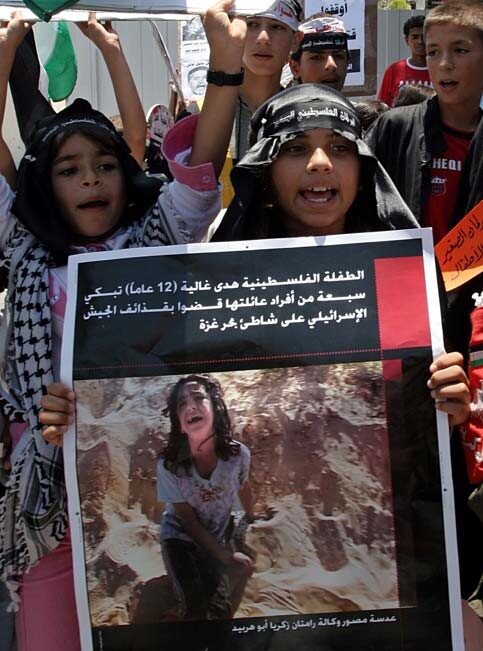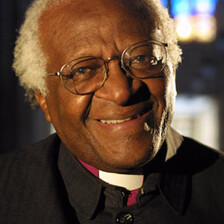The Electronic Intifada 21 June 2006

Palestinian children hold a mock trial of Israeli Army Minister Amir Peretz for his massacre of the Ghalias family on Gaza beach during a protest outside of the UN offices in the Gaza Strip. The Palestinian child who played the part of Amir Peretz was symbolically handed over to the UN representative in Gaza to be taken to the International Court and tried for his crimes, June 18, 2006. (MaanImages/Wesam Saleh)
If you keep lying long enough and with enough conviction, people start to believe you — or at least doubt the evidence in front of their own eyes. And so it has been with the Israeli army’s account of how seven members of a Palestinian family were killed, and dozens of other Palestinians injured, during shelling close by a beach in Gaza.
This week, according to reports in the Israeli media, even Marc Garlasco, a Pentagon expert on the effects of battlefield weapons hired by Human Rights Watch to investigate the deaths, “conceded” that he could not contradict the findings of the Israeli army’s own inquiry.
Presumably that is because Israel is not letting him or anyone else near their evidence. But Garlasco’s slight change of tune — even if it is not exactly a ringing endorsement — leaves the door ajar just wide enough that the Israeli army will doubtless slip through it to escape being held accountable yet again.
The army has been claiming for more than a week, based on its own evidence, that the lethal explosion was not caused by a stray shell landing on the Gaza beach but most probably by a mine placed there by Palestinian militants to prevent an Israeli naval landing.
The army’s case could be dismissed outright were it not for the racist assumptions that now prevail as Western “thought” about Arabs and Muslims.
To be plausible the army account requires two preposterous assumptions: first, that Palestinian militants are so fanatical that they consider it acceptable to lay a mine secretly in an area frequented by local families; and second, that they are so primitive that their best military minds could not work out the futility of placing a single mine along miles of coastline that could be used for a landing (or are we to assume that there are many more of these mines waiting to explode?).
To support its case, the army has produced two pieces of evidence that apparently make its denials of responsibility “airtight”.
First, it claims that a piece of shrapnel removed by doctors from an injured Palestinian transferred to an Israeli hospital was not from one its shells but more likely from a Palestinian explosive device.
Given that, unlike Israel, the Palestinians do not have any factories manufacturing mines or rockets and are forced instead to make them out of any spare metal parts they can get their hands on — doors, pipes, wrecked cars, fridges — this evidence is meaningless. Palestinian witnesses have already said the beach victims were standing close to taxis when the shell exploded. So if the shrapnel was not from an Israeli shell, it suggests only that the missile also damaged other metal objects — possibly the cars — sending a shard into at least one of the victims.
The army will have a lot of explaining to do if reports on Israeli TV, not usually noted for its independent approach, confirm that a piece of shrapnel found in another victim is from an Israeli shell. So far, of course, the army is denying the report.
The second piece of evidence is supplied by the army, which says one of its many drones that circle overhead spying on Gaza round the clock shows the families calmly still on the beach, and later an ambulance arriving, tens of minutes after the army had finished shelling the area.
The problem with the Israeli evidence is that we have to take the army’s word for it: that the families shown are the ones who were about to be shelled, and that the timings given are accurate.
It also means we have to discount a lot of counter-evidence supplied by Garlasco, journalists, doctors and Palestinian witnesses — and even the Israeli army. The army, for example, has admitted that one of the shells it fired in the area is unaccounted for, a striking admission in itself. The drones apparently were no help in locating this “missing” explosion, even though they were spying on the area.
Garlasco has already determined that the injuries sustained by the beach victims accord with a blast above ground — an Israeli shell — rather than one underground — a Palestinian mine.
The many Palestinian witnesses have all put the time of the blast close to when the shelling occurred, and report that the reason they were queuing for taxis was because of panic sown by the shells they were hearing landing nearby.
Independent journalists have shown that, according to the times logged in the computers of the hospital that admitted the dead and injured, the first blood tests were taken soon after the Israeli army shelling — and certainly too soon to accord with the army’s account of when the Palestinian mine supposedly exploded. Doctors have also confirmed that they were called to the nearest hospitals well before 5pm — at about the time, or even before, the army claims the mine went off.
The outrage expressed in some quarters at the failure simply to believe the army’s version might sound more convincing were Israel welcoming an international investigation to adjudicate on the matter. But of course it is not. Just as in spring 2002, following the deaths of many civilians in the Palestinian town of Jenin and the destruction of the heart of the local refugee camp during a prolonged attack by the Israeli army and air force, Israel is rejecting all demands for an independent inquiry.
So why not just take Israel’s word for it? Its army is the most moral in the world, after all, and a state of law like Israel would gain nothing from lying in such a bare-faced manner.
The only problem is that Israel and its security forces have been caught out lying repeatedly during this intifada and before it, not just to people on the other side of the world who cannot verify the facts but also to its own courts and public.
This week, for example, the Supreme Court ordered the army and Ministry of Defence to pull down several kilometres of the steel and concrete barrier they have erected on Palestinian land in the West Bank after it was proved that the security considerations behind the choice of the wall’s route were entirely bogus. Official documents reveal that the wall was located there to allow for the future expansion of nearby illegal Jewish settlements on yet more Palestinian land. The army and government concocted the fib and then stuck to it for more than two years. Chief Justice Aharon Barak called their systematic lying “a grave phenomenon”.
And at the start of the intifada, back in October 2000, the government and police covered up the fact that live ammunition and sniper units trained to deal with terror attacks had been used against unarmed Arab demonstrators inside Israel. For more than six months the government and security services denied that a single live round had been fired, despite mounting evidence to the contrary that lawyers and journalists like myself had unearthed.
They might have got away with their brazen lies too, had it not been for an unusual series of events that led to the appointment of a state inquiry headed by a Supreme Court judge, Theodor Or, who quickly exposed the truth.
That happened not because of any urge by official bodies to come clean or because of the inevitability of Israeli justice. It happened for one reason alone: the prime minister of the day, Ehud Barak, feared losing the impending general election to his rival Ariel Sharon and thought he could buy back Arab votes by setting up an inquiry.
The inhabitants of Gaza have no such leverage inside the Israeli legal and political systems. They have no friends inside Israel. And now it looks like they have no friends in the international community either.
Jonathan Cook, based in Nazareth, is the author of “Blood and Religion: The Unmasking of the Jewish and Democratic State”, published by Pluto Press and available in the US from University of Michigan Press. His website is www.jkcook.net.
Related Links




